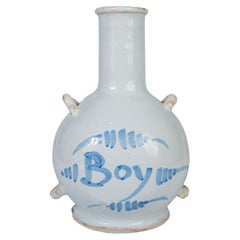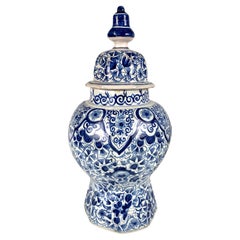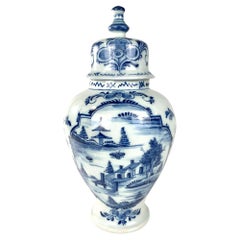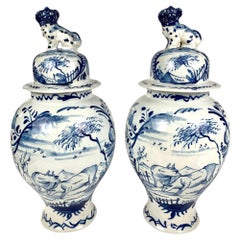Want more images or videos?
Request additional images or videos from the seller
1 of 9
Blue and White Bottle Named "Boy" Made circa 1750
$1,700List Price
About the Item
- Attributed to:Nevers (Manufacturer)
- Dimensions:Height: 8 in (20.32 cm)Diameter: 5 in (12.7 cm)
- Style:Country (Of the Period)
- Materials and Techniques:
- Place of Origin:
- Period:
- Date of Manufacture:circa 1750
- Condition:Small expected edge frits.
- Seller Location:Katonah, NY
- Reference Number:1stDibs: LU86657902103
About the Seller
5.0
Recognized Seller
These prestigious sellers are industry leaders and represent the highest echelon for item quality and design.
Platinum Seller
Premium sellers with a 4.7+ rating and 24-hour response times
Established in 1962
1stDibs seller since 2009
492 sales on 1stDibs
Typical response time: 1 hour
Authenticity Guarantee
In the unlikely event there’s an issue with an item’s authenticity, contact us within 1 year for a full refund. DetailsMoney-Back Guarantee
If your item is not as described, is damaged in transit, or does not arrive, contact us within 7 days for a full refund. Details24-Hour Cancellation
You have a 24-hour grace period in which to reconsider your purchase, with no questions asked.Vetted Professional Sellers
Our world-class sellers must adhere to strict standards for service and quality, maintaining the integrity of our listings.Price-Match Guarantee
If you find that a seller listed the same item for a lower price elsewhere, we’ll match it.Trusted Global Delivery
Our best-in-class carrier network provides specialized shipping options worldwide, including custom delivery.You May Also Like
Set of 5 Circa 1900 Blue and White Delft Vases from Holland
Located in Dallas, TX
A beautiful set of five blue and white Delft vases, this faience collection was hand-painted in Holland, circa 1900. The three bulbous vases are lidded, each with a finial depicting a rampant lion with a ball in its forepaws. Beneath the lion is a mottled background (on the front side only), with a foliate and floral margent. Each vase has the same scene painted on the front of the main body: a couple walking through a field surrounded by flowers. The opposite side has a floral rinceaux above a foliate branch. Painted in a similar fashion, the two concave vases are without lids. The side opposite from the cartouche of the couple has floral margents. All five vases have canted corners on the base.
Inspired by Italian majolica, the faience produced in 16th century Holland...
Category
Antique Early 1900s Dutch Delft and Faience
Materials
Delft, Paint
Blue and White Delft Handled Chinoiserie Vase
By Delft
Located in New York, NY
Blue and white Delft handled chinoiserie vase. Antique Dutch porcelain vase with rich blue flowers and chinoiserie fencing in a lustrous glaze; with scro...
Category
Antique Late 18th Century Dutch Chinoiserie Delft and Faience
Materials
Ceramic
18th c. Italian Blue and White Tin Glazed Apothecary Jar
Located in Greenwich, CT
An 18th century Italian apothecary jar with blue and white tin glazing and hand painted decoration depicting a hilltop village in a lush settin...
Category
Antique Mid-18th Century Italian Baroque Delft and Faience
Materials
Ceramic
Large Antique Italian Blue and White Lidded Urn, 19th Century
Located in Dallas, TX
This stunning lidded urn might have once been found in a 19th century Italian apothecary. The front of the shaped urn body has the hand-painted phrase “C. Violaru”, which is the heavily abbreviated form of the Latin word for violet (violaceum). Up until the mid-1700’s, apothecaries would make syrups from violets and use it to treat kidney ailments.
Above the Latin wording is a whimsical musical scene with a man blowing a horn leading a couple who is holding hands over rocky terrain lined with shrubbery. A large house and trees can be seen behind the trio with a pair of mountains in the distance. On the opposite side of the urn is a floral display with a bird perched on a rock. Beneath the bird is a geometric design, possibly a stylized sun with radiating beams of light. Both scenes are segmented by a pair of thin quarter round moldings that encircle the entire vase.
Other hand-painted motifs include floral and foliate margents, geometric patterns, and Vitruvian waves that are infilled with horizontal fluting. The sides of the urn have a fish-scale background beneath two mustachioed mascarons. Both men have been styled in grotesque fashion, with a pair of spiraled horns emanating from their heads. In between the horns is a looping handle that is affixed to the body in similar tight spirals. The domed lid has three scrolled arms that merge in a geometric finial.
The base color of the urn is white, with illustrations in a monochromatic cobalt oxide blue, reminiscent of Delft blue pottery...
Category
Antique 19th Century Italian Urns
Materials
Porcelain
Early 18th Century Blue and White Dutch Delft Clobbered Vase
Located in Fort Lauderdale, FL
A blue and white Dutch delft vase made circa 1700, with clobbered-style polychrome enamels added in the mid-18th century.
This brightly colored blue and white Dutch delft vase is a ...
Category
Antique Early 18th Century Dutch Dutch Colonial Vases
Materials
Delft, Pottery
18th Century French Blue and White Hand Painted Faience Delft Vase
By Delft
Located in Dallas, TX
This important antique vase was crafted in France, circa 1780. Octagonal in shape with gadrooned body style and a tall neck, the elegant potiche features a hand painted medallion dep...
Category
Antique Late 18th Century French Louis XV Delft and Faience
Materials
Ceramic, Faience
Blue and White Dutch Delft Lidded Jar in Chinoiserie, Early 18th Century
By Delft
Located in AMSTERDAM, NH
An Early Dutch Delftware lidded jar with chinoiserie decoration.
Origine: Delft, The Netherlands
Date: Early 18th century
Workshop: Unknown.
A genuine blue and white lidded j...
Category
Antique Early 18th Century Dutch Chinoiserie Delft and Faience
Materials
Ceramic, Delft, Faience
$3,552
Free Shipping
H 10.24 in Dm 7.09 in
19th Century French Blue and White Delft Faience Vase with Windmill Scenes
By Delft
Located in Dallas, TX
Decorate a console or buffet with this elegant antique vase. Crafted in France, circa 1880, the tall faience vase is beautifully shaped with a rounded body and a long, thin neck. Han...
Category
Antique Late 19th Century French Vases
Materials
Faience, Ceramic
Mid-Century Dutch Faience Blue and White Painted Delft Ginger Jar with Lid
By Delft
Located in Dallas, TX
Crafted in Holland, circa 1950, the large faience potiche features hand painted medallions with Classic Dutch flower and foliage decor. The traditional blue and white jar is round in shape and has a cone lid embellished with dog figure at the top. The tall jar...
Category
Mid-20th Century Dutch Jars
Materials
Ceramic, Faience
Pair of Blue and White Faience Royal Sphinx Delft Ginger Jars with Foo Dog Lids
By Delft
Located in Dallas, TX
Add classical charm to your décor with this exquisite pair of lidded Delft ginger jars by Royal Sphinx, Maastricht. Hand-painted in Holland circa mid-20th century, these striking blu...
Category
Mid-20th Century Dutch Jars
Materials
Ceramic, Faience
$1,800 / set
H 17.5 in Dm 9 in
More From This Seller
View All18th Century Blue and White Delft Jug Inscribed 'Boy' Hand-Painted Circa 1750
By Delft
Located in Katonah, NY
This blue and white English Delft jug, made circa 1750-1760, has a tall, narrow neck with a slightly flared rim on a distinctive globular body. The decoration is the word "BOY" framed by blue dashes.
It is hand-painted in blue, done in a freehand, fluid style that includes typical irregularities in the paint.
Historically, 18th-century English Delftware is known for its freehand, fluid decoration, characterized by minor irregularities that evoke an authentic folk art quality.
The rustic and uneven glaze is also characteristic of this pottery.
The jug has a utilitarian feel, featuring four protruding lugs on the sides.
Its modest yet charming form, rounded shape, and understated ornamentation reflect the everyday aesthetic of mid-18th-century Delftware production.
Delftware jugs were often created for public houses, and "Boy" might reference part of a pub name, a local drinking song, or a common toast.
Just as likely, given England's strong maritime traditions, this could refer to a sailor's drinking vessel.
In naval and military slang, "Boy" was often used to refer to young sailors or recruits.
This hand-painted inscription adds a personal touch, making this jug a unique and engaging example of antique Delftware...
Category
Antique Mid-18th Century French Country Delft and Faience
Materials
Faience, Delft
Antique Delft Blue and White Jar Made by The Claw Netherlands Circa 1790
By The Claw
Located in Katonah, NY
This hand-painted jar and cover from circa 1790 boasts beautiful Dutch Delft floral artwork.
The intricate design features a stunning array of blooms and vines in deep and medium cobalt blue.
The shoulders of the jar are adorned with lappets filled with flower heads, and its octagonal form is topped with a simple, deep blue knop.
Dimensions: 12.75" tall x 6" at widest point x 4.75" across base
Condition: Excellent with small edge frits invisibly restored
Price: $1160
Background of Dutch Delft:
The technique of making Delft was first described in writing by Gerrit Paape in "The Delft Pottery Maker," written in 1794 and dedicated to Lambertus Sanderus, the owner of De Porceleyne Claeuw (The Porcelain Claw). Delft faience began in the 17th century. Much of the most beautiful Delft was produced in the Dutch city...
Category
Antique Late 18th Century Dutch Rococo Jars
Materials
Delft
Antique Blue and White Delft Mantle Jar Netherlands circa 1780
Located in Katonah, NY
This charming blue and white Dutch Delft jar is decorated in shades of cobalt blue.
Hand-painted in the late 18th century circa 1780, the jar mixes rococo and chinoiserie design elem...
Category
Antique Late 18th Century Dutch Rococo Jars
Materials
Delft
Pair Antique Blue and White Delft Jars Hand Painted Netherlands Circa 1770
Located in Katonah, NY
This pair of Dutch Delft mantle jars was hand-painted in the Netherlands circa 1770.
The decoration captures the quiet poetry of the Dutch countryside.
Each jar is painted in lumin...
Category
Antique Late 18th Century Dutch Rococo Jars
Materials
Delft
Blue and White Delft Vase Hand Painted 18th Century Netherlands, circa 1760
Located in Katonah, NY
This blue and white Delft jar was made in the Netherlands in the early 18th century, circa 1730.
The jar is covered in a gorgeous light blue glaze traditional to much early 18th ce...
Category
Antique Early 18th Century Dutch Rococo Vases
Materials
Delft
Delft Blue and White Vase Hand Painted 18th Century circa 1780 Netherlands
Located in Katonah, NY
Made circa 1780, this 18th century Dutch Delft vase was hand painted with floral decoration of flowers and scrolling vines.
A beautiful deep cobalt blue covers most of the surface....
Category
Antique Late 18th Century Dutch Rococo Vases
Materials
Delft



